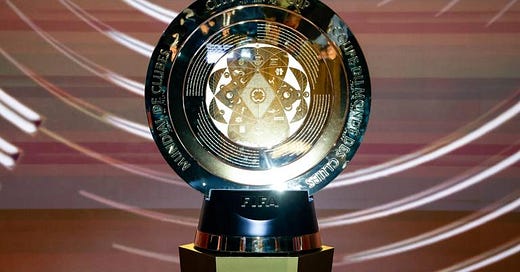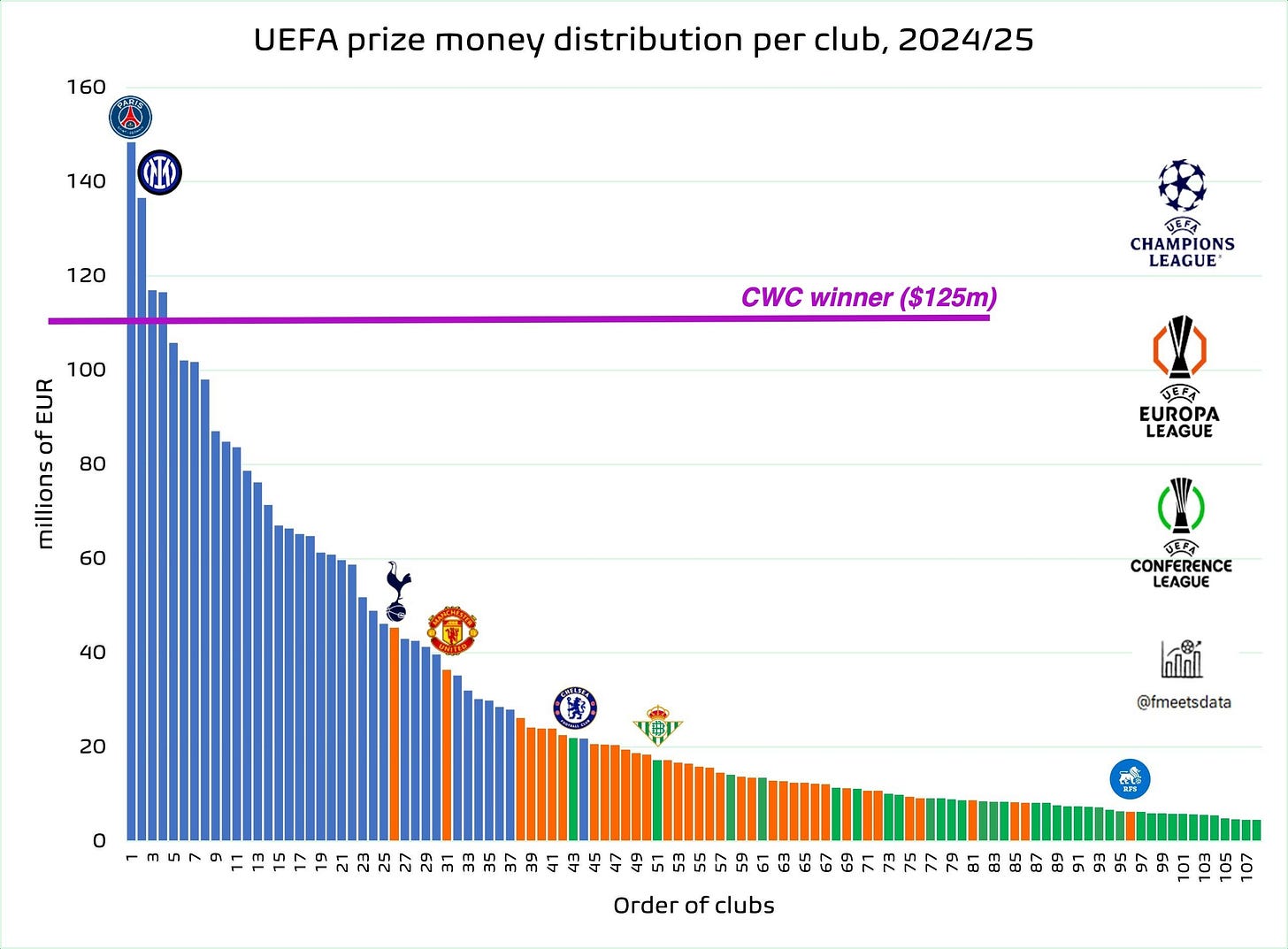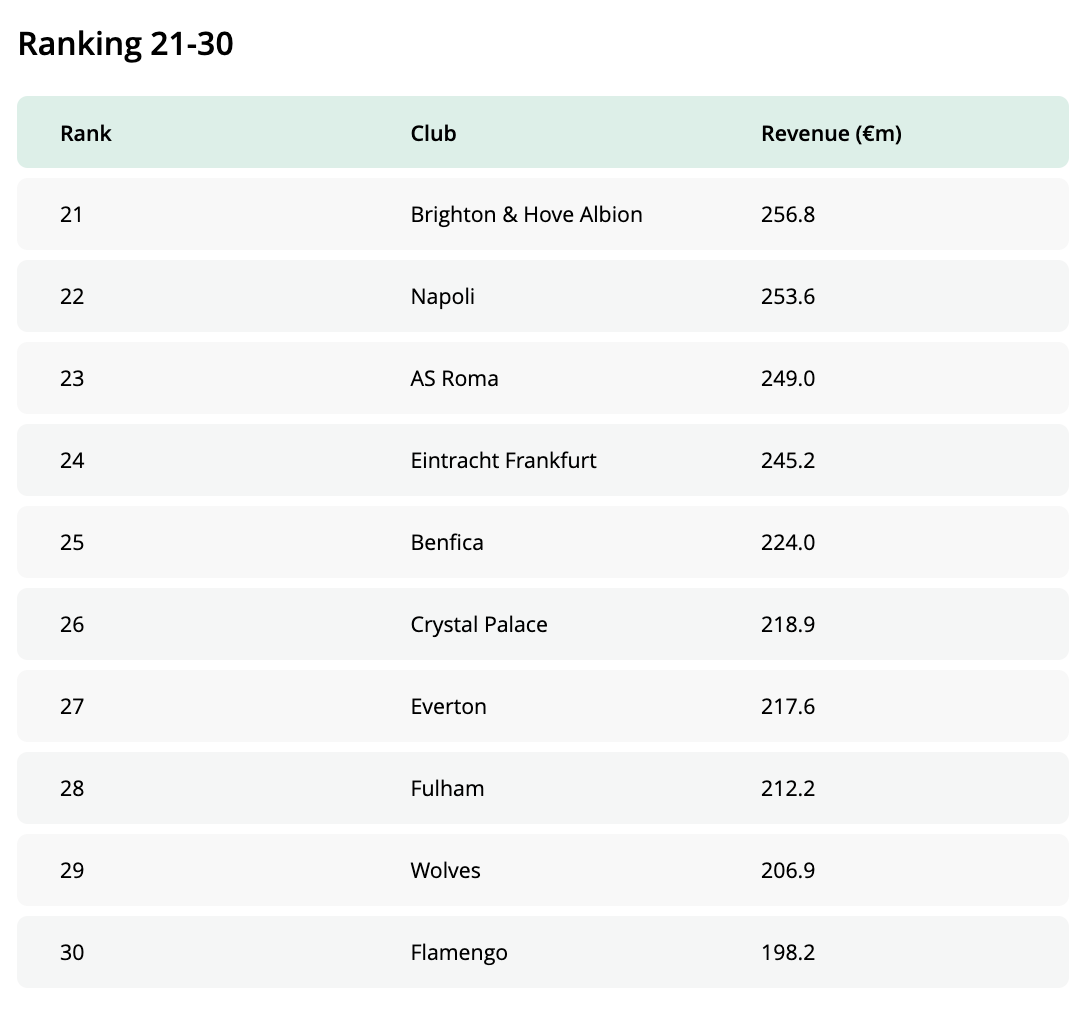What $700m between the 12 European Club World Cup qualifiers means for the future of the game
As Newcastle scrimp, PIF lavishly fund their Champions League rivals
It is finally here.
The players are rested - some of PSG’s Portuguese players even had a lie-in on Monday - and the long two week wait for club football to return is almost over. With one or two notable exceptions, after weeks of games whose only purpose was cash and not trophies, we finally have a whole tournament where all but a handful of teams are focussed on the money. And what money it is.
It took until March 2025 for FIFA to find a broadcast partner for the new Club World Cup format. For many reasons, the concept sounded better in the planning phase than the impending reality.
The opening game of Al Ahly v Inter Miami is unlikely to get Europeans staying up on a Saturday night/Sunday morning especially as Robbie Williams will no doubt perform Let Me Entertain You. Fittingly, finger-on-the-pulse FIFA have chosen a 51 year old star as their 2025 “music ambassador.” That’ll win the TikTok generation over.
Then again, FIFA was also desperate to get the genuinely TikTok-friendly Inter Miami squeezed into the tournament despite it now being a Masters team. So what do I know.
Will They Entertain Us?
The prospect of watching a near 38 year old Messi, a 38 year old Suarez and a near 37 year old Busquets battle it out against Egypt’s “Best Players That Aren’t Good Enough To Play in Europe or Saudi Arabia” is not quite what was envisaged in the original Powerpoint presentation made in the board room at FIFA a few years ago.
It is not a surprise that Channel 5 was the best (only?) offer DAZN had for a UK sub-licensing deal. Channel 5 will show 15 group games, four last-16 ties, two quarter-finals, one semi-final and the final. We don’t know what percentage of the $1bn they are paying DAZN but it is surely less than 1% ($10m). Here are the first five days with BST times - will anybody watch?
We can’t wait to pull out
Earlier this year, Real Madrid were said to be contemplating pulling out. That was publicly denied after Carlo Anchelloti publicly confirmed it. Nevertheless, despite the scepticism and, coincidentally, just three months after the real World Cup was announced for Saudi Arabia in 2034, Gianni Infantino managed to secure a fantastical pot of Saudi Arabian cash to keep even the biggest clubs engaged.
The prize money is part of a record-breaking $1bn pool dedicated to the tournament largely funded by DAZN’s extraordinary, and wholly uncommercial, TV deal. Coincidentally, DAZN in turn raised the cash to pay for the deal from Newcastle United owner, PIF via a 10% minority investment valuing DAZN at an extraordinary level for such a heavily loss making media company.
Big money, fast
The winners of the CWC could earn up to $125m by mid-July. The dollar is weakening but to contextualise $125m in UEFA competition €uro terms, it is bettered only by the Semi Finalists of the 2024/2025 Champions League and dwarfs the other UEFA tournaments. In short, it is massive money and it is going to be in the banks of the clubs before July is over. The transfer window will be wide open.
Europe and the rest
The reality is that the winner’s pot is likely to go to one of the 12 European teams and, most likely, to one of a handful of those clubs. It is no wonder that the pre-CWC transfer window has already seen action with City, Chelsea and Real all making moves. City, in particular, appear to see an opportunity to make up for the sporting disappointment of 24/25 with a push to ensure they capture as much lost revenue as possible after their (relatively) pathetic Champions League performance.
Unsurprisingly, the European clubs have successfully negotiated a heavily weighted participation pillar - the amount payable for qualifying and turning up. From the $525m participation pot, Europe’s 12 competing clubs will scoop $306m (58%). That $306m has then been divvied up to weight the distribution to the UEFA clubs with the best recent performance.
FIFA has not broken down what each European team will get but we can make some educated guesses based on the 23/24 data.
City and Real Madrid look very likely to receive over $35m each just for turning up. Bayern, PSG and Chelsea will not be far behind (if at all). Inter Milan have confirmed they will receive just under $25m:
FC Salzburg will only receive a third of the top club ($12.8m). But even this will be roughly 4x the Oceania qualifier (Auckland $3.58m) and more than all of the non-South American qualifiers ($9.6m).

But wait, there is more. Much more.
The real prize comes from the knock out phase and the sporting performance pillar. Most of the European teams will expect to win 2 from 3 in their groups and to qualify for the Round of 16 (the top 2 in each group). 2 wins are worth $4m and would also likely guarantee the $7.5m R16 revenue. There are 48 group games equating to $96m of the $475m in the sporting pillar.
That leaves $379m for the knock-out prize money - so $379m shared between the remaining 16. $259m of that, goes to the last 8. It is likely that at least five Quarter Finalists will be European adding another $13.125m each.
So, the top European sides are virtually guaranteed revenue of $40-50m each. Indeed, of the $475m sporting pillar, we can surely expect Europe to capture the vast majority - quite possibly over $400m (85%). And a total of $700m across the two pillars. That’s $700m for just 12 teams, at most.
Big for some, distortive for others
These are serious amounts for all clubs but for Benfica, Porto and FC Salzburg, these are potentially transformational revenues representing around 25% of annual turnover for Benfica and Porto and much more for FC Salzburg. None of these clubs are even in the Deloitte Money League Top 20 by revenue. Porto and FC Salzburg aren’t even in the Top 30.
For Porto and Benfica, they could realistically earn more from this Club World Cup than the entire revenue of every other club in Primeira Liga except for Sporting. Remember, this is a league where 10 of the 18 clubs generate less than €8m total revenue and over 83% of the total €615m total revenue comes from just 4 teams - Benfica, Porto, Sporting and Braga.
The Austrian league, home of FC Salzburg, is minor on any measure. It is 14th by revenue in UEFA’s recently published analysis. Total revenue of all Austrian Bundesliga clubs was €271m in 23/24 which is similar to Brighton’s alone (€256m).
Don’t forget the costs
Most of the commentary about the value to the clubs forgets the costs. Martyn Hawkins doesn’t in his piece here. These will include:
Travel and accommodation - 5 star resorts, food, training facilities and flights, for say, a minimum of 50-60 football staff plus catering, communications personnel and senior executives are more expensive than most people estimate. And this could go on for up to 4 weeks. Some clubs will have paid non-refundable deposits for rooms in resorts for the knock out phases.
Bonuses - you can be assured that player representatives have been negotiating hard. Many contracts will not have specific provision for Club World Cup bonuses or provide for the old style, minor, tournament. The players are aware that they are being asked to risk further impact on their bodies and that the clubs are generating the amounts detailed above. On the club’s part there is a real purpose to incentivisation. If you can motivate the players with big bonuses to get to the Quarters and Semis, this has real upside. Without cash incentivisation, is the tournament really prestigious enough for the players?
Contracts - most contracts in football expire on 30 June. Kevin de Bruyne asked himself why he’d risk playing - other players may have signed short extensions. And, of course, Real Madrid paid £10m just to have Trent Alexander Arnold for the month of June.
For a like for like comparison with other tournaments it is also important to remember that this time, none of the matchday revenue goes to the clubs - all of that is going to FIFA and the venues. If these games really sell out at these ticket prices (they won’t of course), some of these games could gross more than $10m.
A competition that’s for the owners not the players?
For the European qualifiers, the CWC will provide a second substantial boost to revenues just as non-qualifying clubs see the stark financial impact of the expanded Champions League. As it’s all come together so late, the CWC may be the first substantial revenue generator that doesn’t largely end up being paid away to the players. But this upside will be short lived - future contracts won’t fail to consider it and dressing room leaders will be better armed to negotiate bonus packages in four years time.
Perennial Champions League qualifiers from leagues outside of the Big 5 or 6 leagues may well also see the opportunity to benefit from the two-team-from-each-league cap. Such teams could attract a new kind of investor interested predominantly in the riches of the non-domestic club cups. Teams like Club Brugge, Celtic/Rangers and PSV/Feyenoord/Ajax could finally make more financial sense than those outside the top 4 of the Big 6 leagues.
The flip side of all of that is that the Club World Cup at this scale of prize money has the potential to embed the leading European teams (and the other 20 participants) at the top of their respective domestic leagues with little trickle down benefit at all.
It is one to watch, perhaps even more than the tournament itself.















American fans are staying away in droves and it doesn’t seem like international fans are making up the difference. Do you think there will be enough commitment to continue the CWC should its organizers and broadcasters take a financial bath?
Great info - as always - Stefan.